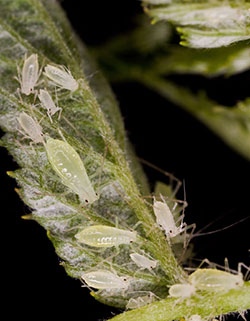There are several factors that can cause little or no fruit production on established raspberry plants. One that everyone thinks of is improper pruning – removing canes annually on summer-bearing (floricane) types that only produce on canes during their second year of existence. Note that you should prune fall-bearing (primocane) types annually—in their first year of existence—after harvest in the fall.
What is the most common reason for raspberry problems?
Viruses are perhaps a more common reason for l ack of production. A raspberry planting is productive for about ten years and yields best in the first five years after planting. Aphids introduce various viruses, which accumulate in a plant over time. These viruses produce no obvious mosaic or visible plant symptoms.
ack of production. A raspberry planting is productive for about ten years and yields best in the first five years after planting. Aphids introduce various viruses, which accumulate in a plant over time. These viruses produce no obvious mosaic or visible plant symptoms.
When should I remove diseased plants?
Remove plantings after ten years or when they begin to yield poorly and make a new planting, preferably in new soil. Obtain virus-free planting stock from reputable nurseries. Don’t plant donated rooted suckers from another gardener because they might be virus-riddled. Poor-quality fruit can also be due to viruses such as Crumble-berry virus which causes exactly what its name implies.
What causes make raspberries produce poorly?
Short plants that fail to thrive and produce poorly can be from several causes.
- Raspberries perform poorly in heavy soils with poor drainage. They produce best when grown in raised beds in soil you amend before you plant.
- Raspberries perform poorly in a xeric environment. When you water them irregularly or inadequately, you might get short plants. Water raspberries an inch of water per week for good production.
- Raspberries will not thrive under crowded conditions. Thin canes to 8 inches apart in spring as early growth starts.
- Raspberries require fertile soil to thrive. Apply a general nitrogen fertilizer.
- Raspberries produce poorly with inadequate light. Plant raspberries in an area with at least 6 hours of direct sun daily if part of the day is shaded, it’s best in late afternoon.
- Spider mite infestation causes yellow spots that turn into bronzed foliage. Mites are more of a problem in hot locations and during hot summers. To control spider mites, provide adequate water and spray the undersides of leaves as needed.
- The raspberry cane borer causes wilted and drooping tops of canes. To prevent the white larvae from tunneling down further into the cane, prune off the cane tops at the earliest sign of the insect. Destroy pruned branches containing the insect. Insecticides such as carbaryl (Sevin®) are registered for this pest.
- Sunscald and heat are the cause for white druplet disorder on the fruit. A few of the druplets or perhaps an entire sun-exposed side of a berry turns white. The rest of the fruit colors normally. This does not harm the edibility of the fruit, just the appearance. It is an environmental disorder and not one caused by a fungus or bacteria so no sprays are needed. Good leaf cover will be helpful so put efforts into adequate watering and fertilizing.
For more information, see the following Colorado State Extension fact sheet(s).



